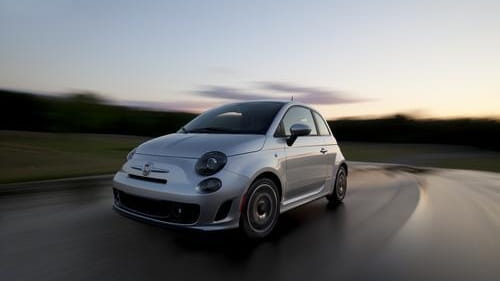Fiat 500 Turbo is brand's best 2013 model

On price, performance and features, the Turbo model offers the best balance of the 2013 Fiat 500's attributes. Credit: Chrysler Group LLC
Chrysler-Fiat's Italian-bred sub-compact finally appears to be gaining headway with small-car shoppers.
That should become even more in evidence with the recent arrival of the Turbo that rounds out a four-model 500 lineup, which already includes a base 500, 500c Cabrio convertible and performance-focused 500 Abarth.
Making its presence felt on the North American automotive stage has been challenging for the two-door 500, especially when compared to other more iconic and established makes, including its Mini Cooper nemeses. Then there are the other small-car brands from Chevrolet, Ford, Honda, Toyota, Hyundai and Kia that come with an extra set of passenger doors and some very impressive fuel-economy numbers of their own.
The equally frugal 500 family still has some miles to go before reaching icon status in North America. In most cases, its youthful buyers have only minimal knowledge of the Fiat marque or the "Cinquecento" itself. From 1957-'75, the Turin, Italy-built 500 was a bare-bones-basic coupe with its engine in the rear just like the original Volkswagen Beetle. A half-century after its creation, the 500 was revived in Europe as a front-wheel-driver, configured as a hatchback with more passenger and cargo space, just like the current Beetle.
The Mexico-built 500 enters it third season, tempting buyers who want spend less on gas but still crave stylish wheels when commuting.
The base 500 hatch and Cabrio operate with a 101-horsepower 1.4-liter four-cylinder "Multi-Air" engine and standard five-speed manual transmission. For 2013, the engine has been tweaked to produce 31 mpg in the city and 40 mpg on the highway using premium fuel. That' an increase from the previous 30/38 rating and is considerably better than models equipped with optional six-speed automatic transmissions that measure out at 27 city and 34 highway. Oh, you can use regular gas in the tank if you're stuck, but output and fuel economy will dip.
At the opposite end of the scale, the Abarth (named for Fiat tuner Carlo Abarth) comes with a turbocharged version of the 1.4 that puts out 160 horsepower and 170 pound-feet of torque (also using premium fuel) and is exclusively equipped with a five-speed manual gearbox.
Bridging the gap between base and Abarth is the new 500 Turbo. As the name implies, its 1.4-liter engine is also turbocharged, but has been detuned to 135 horsepower and 150 pound-feet of torque. That's 25 ponies less than the Abarth, but the $20,200 Turbo model also costs $2,500 less, which, at $100 per horsepower, seems fair enough.
While 135 horsepower might not seem like a lot, look at it this way: it's 35 percent more than the base cars while torque is ahead my more than 50 percent. Now those numbers are indeed big.
Also note that the Turbo and the Cabrio arrive identically priced, allowing you to choose between top-down summer fun or extra performance for the same money. Hmm, decisions, decisions.
Keep in mind that the Turbo copies the Abarth's manual-transmission-only requirement so if you're averse to giving your left foot and right arm a workout while driving, the decision has already been made for you. For the record, the Turbo's mpg numbers are 28 city and 34 highway.
The Turbo arrives with plenty of add-ons, including a distinctive nose and rear end (similar to the Abarth's), unique bodyside trim and alloy wheels and a liftgate-mounted spoiler. Along with a standard sport-tuned exhaust, the transmission, suspension and braking system have been beefed up to better handle the added performance and help tame the dreaded torque steer (the tendency for front-wheel-drive vehicles to veer to one side under hard acceleration).
The Turbo also comes with sporty-style bucket seats and fancier trim, while climate control, voice-activated navigation system, leather-covered and heated front seats and a Beats by Dr. Dre audio package are optional.
For small-car fans with champagne tastes on a beer budget, the 500 Turbo should manage to deliver some extra kick and give Fiat fans a more stylish way to navigate from A to B.
What you should know: 2013 Fiat 500 Turbo
Type: Two-door, front-wheel-drive sub-compact hatchback
Engine (hp): 1.4-liter DOHC I4, turbocharged (135)
Transmission: Five-speed manual
Market position: The Sub-compact vehicle class is growing in popularity with recent entries from Chevrolet and Toyota (Scion) joining the ranks. Adding new models to the 500 line appears to be paying off for the Fiat brand.
Points: One of the least expensive turbocharged models you can buy; Mild turbo version shores up underperforming base engine; Interior still a comfy spot for front passengers despite diminutive size; Abarth costs $2,500 more for those seeking additional performance, but the Turbo's $4,000 premium over the base cars seems a bit wide.
Safety: Front airbags; side-impact airbags; side-curtain airbags; driver's knee airbag; anti-lock brakes; traction control; stability control.
MPG (city/hwy) 28/34;
Base price (incl. destination) $20,200
BY COMPARISON
Mini Cooper
Base price: $20,400
Sporty looks and slot-car handling, but is pricey for its size.
Volkswagen Beetle
Base price: $20,600
Looks more grown-up than old New Beetle, with more people/cargo space.
Scion iQ
Base price: $16,000
Minimalist practical model is ideal for getting around in crowded cities.
